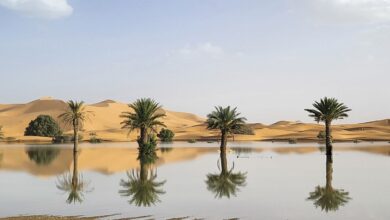
“(The vendor) says it feels really bad,” MacCarthy said. “It doesn’t feel good to be holding very stained clothes or really dirty clothes, but they have to do that … to see what they can sell and what they cannot sell.”
Kantamanto Market in Accra, the Ghanaian capital, has long been a destination for used clothes, but the volume being imported today far exceeds the space. Approximately 15 million garments arrive in the country weekly – most of it at Kantamanto – and about 40% will eventually end up as waste.
MacCarthy is a product development coordinator for the Or Foundation, a non-profit registered in the US and operating primarily in Ghana, that’s tackling this problem on multiple fronts. Using research, advocacy and innovation, the foundation draws attention to textile waste and finds ways to reuse it.
“Every single one of us is a part of the problem in some small way,” MacCarthy explained. “And so every single one of us can be the solution to the problem as well.”

From donation bins to trash bins
The bulk of Kantamanto’s clothes come from the global secondhand clothing trade, a market that was valued at $5 billion in 2021.
Many of these garments begin as donations in places such as Europe and North America. Charities collect clothes, which will either be given away to those in need or sold to raise money for their cause. But these organizations only sell about 10% of items they receive.
The rest go through a journey of sales, where each party buys what they can reuse or resell – until the last buyer is essentially left with the bottom of the barrel.

Merchants at the end of this chain often work in markets like Kantamanto. They purchase used clothing by the bale, without knowing what’s inside, in hopes of selling it for profit. MacCarthy says these bales are usually mislabeled and filled with items in terrible condition.
“I’ve heard somebody who used to sell in Kantamanto say that Kantamanto is for the brave … because not many people would go and buy something that they don’t know the contents of,” she explained. “It is a gamble for many people.”
Because the quality is so poor, the majority of clothes that can’t be sold litter the market’s floor or end up on nearby beaches and in makeshift landfills, according to MacCarthy.
Upcycling waste
To prevent this waste from winding up in landfills, the Or Foundation is remanufacturing it.
MacCarthy works with a team of young women who used to be “kayayei” – female head porters – at Kantamanto, who now make mops from unsold t-shirts.

They start by sorting through retailers’ unsellable clothes and purchasing shirts that are 100% cotton. Back at the organization’s workshop the team gets to work cutting, sewing and assembling. MacCarthy said she deliberately simplified the manufacturing process in hopes that others will replicate it to create mop-making businesses of their own.
MacCarthy’s mission is twofold: diverting waste from landfills while creating employment opportunities for her team. Kayayei carry up to 55 kilos of clothing and earn less than a dollar per trip. Today, about 15 former kayayei have paid apprenticeships at the Or Foundation as part of a program that aims to help them find alternative types of work.
“The goal … is to see whether this is a viable business. And if it is, then we would hand it over to the apprentices … to empower them,” MacCarthy explained. “It’s a business that they can – if they choose to – move forward and make a living out of.”
The team has made several hundred mops and is now working on ways to scale up production.
As they continue refining the manufacturing process, a separate team at the Or Foundation will train the apprentices on the basics of running a business.
A multi-faceted approach
MacCarthy’s team is dedicated to dealing with waste already in Ghana, but other workers at the Or Foundation focus on the wider issue of clothing waste, by tackling overproduction of clothes.
The European Commission recently proposed new rules to hold retailers accountable for the life cycle of their textile products. Ahead of this announcement, the foundation met with policymakers in Europe. The regulations will make the collection of textile waste mandatory in 2025, but the organization says these changes won’t be enough.
“The proposal fails to understand the current practices of the global secondhand clothing trade, and in so doing fails to create a structure for global accountability,” Or Foundation co-founder Liz Branson told CNN in an email.
In the meantime,through MacCarthy’s mop program and similar waste innovation efforts, the foundation says 28 metric tons of clothing have been diverted from Accra’s landfills in the past year.
Successes like these inspire MacCarthy – and she hopes they inspire others as well.
“Whether it’s by signing a petition, whether it is by adding your voice, whether it’s by deciding to upcycle something, whether it is by talking to people about the problem – do something,” MacCarthy said. “Everybody can have a hand in helping to correct this thing in their own little way.”
This story has been updated to clarify that the Or Foundation does not support a ban on importing used clothing into Ghana.




